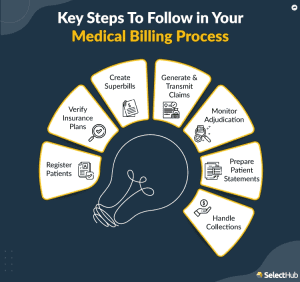On-Demand Outsourcing BPO Services for Healthcare Providers With 24/7 Coverage!
Save up to 70% on staffing costs!
Browse Specialty Staffing ServicesMEDICAL BILLING PROCESS

Author: MANASA
INTRODUCTION
Medical billing is the process of generating health claims to submit to insurance companies for the purposes of obtaining payment for medical services rendered by providers and provider organizations. The medical billing process can be also be frustrating. Processing claims is no easy feat either. It can take months and several communications before you reach the collection stage. In another words medical billing is the process of submitting claims on behalf of patients to receive payments for the services rendered by health care providers.
The medical billing process consists of various other administrative and legal tasks like eligibility and verification, medical coding, charge entry, and claims submission. The focus of medical billing is to ensure that the hospitals, as well as the doctor, get paid for the medical services offered by them. These services may include diagnosis, treatment, Lab test, and outpatient facilities, etc. Medical billing is an integral administrative aspect of the medical profession, and it is such a comprehensive task that it requires a whole new department of professions who are proficient in billing practices in order to deliver results in a swift and efficient manner.
The medical billing includes a cycle and can take in upwards of days to months to complete, and at times take several communications before resolution is reached. As all of us know that the process of medical billing begins with a patient visiting their medical provider and then the patient’s medical record is then updated summarizing the diagnosis, treatment and any pertinent information. Hence this information is then recorded electrically for future account updates.
CONCEPT
- The purpose of medical billing process
As all of us we know that the goal of medical billing process is to prepare claims and submit them to insurance providers. As a result of this process, the healthcare organization is reimbursed for the services they provided to their patients. Without this concept [medical billing] hospital or medical office may not be able to function or continue serving their communities.
Key Steps to follow for a successful medical billing process

To know more about the medical billing process first of all we want to know the steps mentioned below to speed up the billing activities.
STEP 1: Register Patients
- The first and foremost step that we want to do is to note down the patient’s details, such as his/her age, gender, address and phone number, policy number and insurance provider. Create checklists to ensure that we don’t miss gathering critical inputs.
- Many guides to the medical process state that, once we enter collected the patient’s information, need not register them again. Patient registration can be a nightmare. Collecting this entire data is the first step of medical billing process.
- Whenever a new patient calls for a first appointment, we want to ask the series of questions about the patient’s demographics, health insurance information and other key background data.
- The insurance related information is key and also we want note down which includes
- Insurance plain
- Policy ID or number
- Name of insurance payer
- Today most practices use medical billing, EMR or HER solutions
To make data collection processes a breeze.
- In today’s world the technology is improved so in medical billing process advanced medical billing and coding software where patient details are entered only once, and patients do not have to go through of giving information every time they visit the hospital or clinic.
- Hence patient registration is mandatory in medical billing process.
STEP 2: INSURANCE VERIFICATION
- In this step the patients need to verify their insurance information and eligibility in every appointment and visit the medical practice as an insurance plan, and coverage status can change anytime.
- Insurance coverage differs from company to company. For example, most health plan providers don’t cover cosmetic procedures. That’s why it’s crucial to determine financial responsibility.
- The status of insurance is also asked, and only active insurance plains would be processed, and if it is mentioned medical services are covered or not; otherwise, the patient has to make a payment on his own.
- Any changes in the insurance plan or policy impact the patient’s authorization information and benefit.
STEP 3: SUPERBILL CREATIONS
- During check in, the patient will be asked to complete forms for file, or if it is a return visit, confirm or update information already on file.
- We should also ask for official identification such as a driver’s license or passport. And also, we need to collect co-payments before or after the visit.
- Once the client checks out, we need to create and send the medical report the medical coder. The coder will then translate the data to the diagnosis and procedures codes. This is called a “SUPERBILL”.
- Now we can generate a super bill consisting of the client’s demographic and medical and insurance data.
STEP 4: CLAIMS GENERATION
- The medical biller will then use the superbill to prepare a medical claim to be submitted to the patient’s insurance company.
- After generating a super bill, we need to create a paper or an electronic medical claim. Don’t forget to check for coding and formatting errors to avoid denials.
- Each claim should contain the patient’s details and procedures data [CPT or HCPCS codes].
- Claims should also consist of insurance provider information listed through a National provider identifier [NPI]
- Once the claim is created, the biller must go over it carefully to confirm that it meets payer and HIPPA compliance standards, including standards for medical coding and format.
STEP 5: CLAIMS SUBMISSION
- The claim submission is defined as the process of determining the amount reimbursement that the healthcare provider will receive after the insurance firm clears all the dues.
- Once the claim has been checked for accuracy and compliance, submission is the next step.
- In most cases, the claim will be electrically transmitted to a clearinghouse, which is a third-party company that acts as a liaison between health providers and health insurances.
- There are two types of claim submission
- CASHLESS CLAIM…we visit a network hospital and your health insurer take care of the bills.
- REIMBURSEMENT CLAIMS…we need to pay our hospital bills after treatment. Hence claim submission is important in the medical billing process.
STEP 6: MONITOR CLAIM ADJUDICATION
- Adjudication is the process by which payers evaluate medical claims and determine whether they are valid and complicate, and if so, the amount of reimbursement the provider will receive an Explanation of benefits [EOB] statement.
- ADJUDICATION SCENARIOS …Scenario 1-If Payers Accept the Claims…
- Insurance companies accept valid claims with no coding, documentation or data entry errors. When they approve the claim, we will receive an Explanation of benefits [EOB] statement. In this the document contains check details, policy number, patient’s and payment name, and payee’s name etc’’’’
…Scenario 2-If payers reject the claim…
- If a claim’s missing critical data or if it’s miscoded, it’ll be rejected and sent back to you. In such cases, we need to change and resubmit the claim.
…Scenario 3-If Payer Deny the Claim…
- Resend the claim. If rejected again, inform patients about their financial responsibilities.
- Sometimes these procedures take longer than usual. That’s why we should follow up with insurance companies about adjudication statues.
STEP 7: PATIENT STATEMENT PREPARATION
- The statement is a bill highlighting procedures or services rendered by the client.
- we can also attach an explanation of benefits statement with the invoice to explain to patients the reasons behind covering t
- Once the claim has been processed, the patient is billed for any outstanding charges.
- In the statement information also includes the amount paid by insurance and the amount due from the patient.
STEP 8: HANDLE COLLECTIONS
- It is the final step is to mail statements to patients.
- Medical biller must follow up with patients whose bills delinquent, and when necessary, send accounts to collection agencies.
- If clients fail to pay bills within assigned deadlines, it’s our responsibility to initiate follow-up protocols.
- Hence successfully the medical billing process is completed.
- ADVANTAGES OF MEDICAL BILLING PROCESS
- Enhanced transparency.
- Reduced costs.
- Keeps patient data safe
- Speeds up the patient cycle
- Keeps billing up to date with the latest codes, regulations and payer rules.
- Reduces logistical expenses.
- Reduces billing errors.
- Improves patient satisfaction.
- Reliable security.
- Faster claim submissions and Audits; Better Revenues.
- Dedicate more time to patients.
- Compliance with the latest standards.
- DISADVANTAGES OF MEDICAL BILLING PROCESS
- Lack of control over resources.
- Lack of financial resources for conversion.
- Lack of appropriate security protocol.
- Contractual misunderstandings.
- Risks to patient satisfaction.
- No flexibility -once we outsource our billing services then all our business practices come under third-party agencies.
THE IMPACT OF COVID-19 PANDEMIC ON MEDICAL BILLING PROCESS

- The COVID-19 pandemic has had a massive impact on all aspects of daily life, safety, and financial and emotional well-being.
- However, the pandemic is about to bring forth the next generation of care-powered by hyper-connected, community-sourced and digitally-enable healthcare system.
- The COVID-19 Pandemic has created the following medical billing challenges:
- New tracking and billing updates
- Lack of resources strains healthcare practice
- An increase in the number of denied claims
- States are taking action to protect against surprise medical billing
- Revenue cycle impacts
CONCLUSION:
By studying the above information, we concluded that the medical billing process is the part of the healthcare system because it enables care providers to accurately bill insurance providers as well as gather useful data about the treatments, procedures and patient experience.
REFERENCE
Max Freedman, Select Hub, Cap line healthcare management, Med Converge, Bryant Stratton College.
 Book a Demo to Build Your Team Today!
Book a Demo to Build Your Team Today!
 Read Case Studies
Read Case Studies 



 Virtual Medical Assistants
Virtual Medical Assistants



